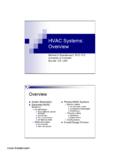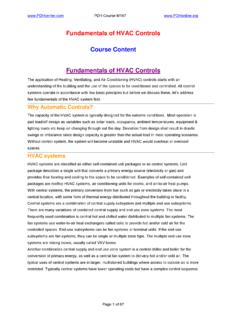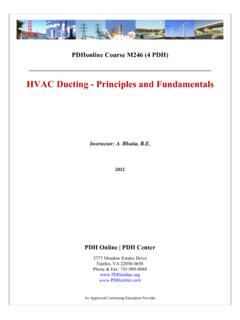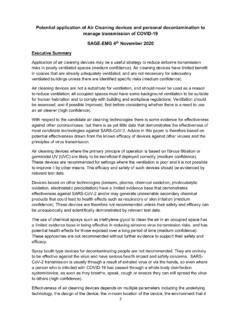Transcription of Basic Capnography - Virginia Department of Health
1 11/17/20091 Mike WatkinsEMT-P, RNClinical Nurse, Cardiac Surgery ICUV irginia Commonwealth University Health SystemVirginia EMS Symposium 2009 Outline: Why Capnography Review Airway Anatomy and Physiology Applied Physics Types of End Tidal CO2 Using Capnography in the Field Overview of EquipmentCapnography 2009 BLS Skill with placement of blind rescue airways King LTD Combitube Applies to any ventilated patient Bag-mask ETI and rescue airways Transport vent CPAP? Noninvasive applicationsCapnography Defined as the monitoring of exhaled carbon dioxide through the respiratory cycle Measuring of End tidal CO2 is considered a standard of care for confirming endotracheal tube placement An important adjunct for assessing a critical patientThe Journey of A Molecule Through the Respiratory Cycle11/17/20092 Fundamental ComparisonHuman BeingGas EngineComparison Human and Gas Engines What do we need to do work (use energy) Fuel (glucose or petroleum) OXYGEN Chemical process: (ignition) What do we give off?
2 (Respiration) Human: Carbon Dioxide Engine: Carbon MonoxideAnatomy ReviewAction at the Alveoli Oxygenation of vital organs is the primary function of the respiratory system Ventilationis the movement of air/oxygen into the lungs Perfusionis the oxygenation of the cells through the alveoli Gas exchange: In with the good, out with the bad Is the bad leaving? ventilation versus perfusion: (V/Q) Is what you are putting in getting to the cells?Alveolar Detail O2 and CO2 exchange across semi-permeable membrane Pressures in blood stream and tissue affect quality of exchangeCO2CO2CO2CO2CO2CO2O2O2O2O2O211/1 7/20093 Normal V/Q RatioAlveolar Perfusion Problems Shunt Problem Blocking of bronchial airways Pneumonia, atelectasis Right main stem intubation Causes retention of CO2, increased levels Dead Space ventilation Capillary flow to alveoli impaired Low Cardiac output, hypotension Excessive PEEP CO2 does not cross into the alveoli for exhalation Decreased levels of expired CO2 Impaired VentilationShunt ProblemDead Space VentilationCardiac Output and CO2 Normal Respiration Oxygen diffuses into blood stream through the alveoli, and is transported to the cells.
3 Cells produce Carbon Dioxide as waste product CO2 transport in venous blood to the capillaries of the alveoli, and diffuse across membrane into alveolar space and exhaled11/17/20094 Measuring End Tidal CO2 Dalton s Law: Total pressure of a gas is the sum of the partial pressures of the gas Expired CO2 measured (PetCO2) mmHg in waveform Percentage Normal Levels PaO2 85-100mmHg PaCO235-45mmHgPercentage vs. mmHg Relate to the air we breath: 78% Nitrogen 21% Oxygen 1% CO2 and other gases Exhaled gases: 16% Oxygen 4 to 5% CO2 PetCO2 vs. PaCO2 PetCO2 End tidal measurement from expired or exhaled air PaCO2 Arterial blood gas sample End tidal normally 2-5 mmHg lower than arterialComparing Arterial andEnd-tidal CO2 Review of Airway Confirmation Visualization Auscultation: Negative Epigastric sounds Equal lung sounds Esophageal detector End tidal CO2 detector Secondary signs: misting, increased SaO2 Types of End-Tidal CO2 Qualitative Yes or No Nellcor, Portex, or built in to BVM Quantitative Numerical value (capnogram) Waveform (capnograph) Mainstream or Sidestream11/17/20095 Capnometry vs.
4 Capnography Capnometry is a numerical value only Capnography is a waveform, providing a visual representation of a ventilation Provides the numerical value Waveform indicates pattern of breathing Quality of ventilation RateQuality is Key Poor Perfusion or Poor ventilation Dramatic alternations in Homeostasis Poor Cardiac Output Equals Poor Perfusion Decreased Carbon Dioxide Pearl of Wisdom In with good air, out with bad Blood goes round and round Qualitative Detectors Detect presence or absence of CO2, but do NOT give specific values or levels Colorimetric pH sensitive paper Color changes with CO2 exposure Limited value once contaminated with moisture, drugs, or body fluids Most common: Nellcor EasyCap II, Portex CO2 clipQuantitative Detectors Electronic, infra-red analyzers Use IR absorption spectrophotometry Certain gases will Absorb IR light Mainstream IR detector in line, at end of ETT, real time Sidestream IR detector in machine, attached by tubing Intubated and non-intubated 3-5 second time delay Capnography Monitors Wide variety: evolving as devices change Oridion supports Microstream Sidestream devices, pulling gases into device Respironics/Novametrix supports Zoll, Propaq MainstreamSample Capnography Display11/17/20096 Sidestream Sensor is located in device like LP12 Adapter tube attaches to ETI Pump in machine pulls air in for measurement 100 to 150 ml air in early devices 50 ml in Microstream Concerns.
5 Delay of 3-5 seconds Quality of sampleSidestream Easier to use non-invasively Key is quality of the patient s respirations Shallow is poor Mouth breathing is challenging Newer devices assist in increasing accuracy Sidestream is LESS specific because of its engineeringSide-stream DetectorSidestream DetectorCannula with mouth scoop Oxygen and sensorMainstream Detector Sensor at end of cable Disposable adapter to ET tube Real time values-best for critical care As the gas passes the IR sensor Concerns: Not easily adapted to non-intubated patient Can be heavy for pediatric of infant ET tubes Cable is expensiveMainstream Detector11/17/20097 Lifepak 12 Monitor/12 lead Configures for critical care monitoring Defib/pacemaker Capnography Sidestream Microstream Downloadable, stores 100 activationsPropaq Critical Care Monitor Vital signs only Capnography Mainstream Critical care central line monitoring Collects and prints trends DOES NOT STORE DATA Zoll M and E series EMS and Critical Care Capnography mainstream and sidestream Depends on model Respironics/Novametrix technology Data collection Phillips Multi-parameter monitors Capnography MicrostreamTidal Wave/Respironics Hand held Combined Pulse Oximeterand Capnography DownloadableNellcor N85 Handheld Combined Pulse Oximeterand Capnography11/17/20098 Normal EtCO2 waveform01020304050 TimeCO2CO2 Parts of the Waveform Baseline.
6 No CO2 is passing the sensor Inhalation/ ventilation by BVM Upslope: rapid rise in CO2 level Exhalation/relaxation of BVM Plateau: rest at end of exhalation May have a gradual rise at end Down slope: rapid decrease as inhalation occursEMS Applications Confirmation of airway placement Endotracheal tube (CO2 present) Gastric tube (no CO2 present) Quality of Cardiopulmonary Resuscitation Tube confirmed, but CO2 levels remain low Poor cardiac output leads to lower PetCO2 Clinical Conditions require the use of trend data and constant minute volumes Pathology Associated Capnography Oxygen and Carbon Dioxide What do the numbers mean Hypoventilation: O2 < 60mm/Hg CO2 > 45mm/Hg (Hypercapnea) Hyperventilation: O2 > 100mm/hg (SaO2 above 98%) CO2 < 35mm/HgClinical Conditions with Increased CO2 Increased CO2 production Bicarbonate administration, fever, seizures, sepsis, thyroid storm Decreased alveolar ventilation COPD (retaining CO2), hypoventilation, muscular paralysis, respiratory depression Equipment Problem Rebreathing, ventilator leakHypoventilationGradual increase in CO2 levels, often from retention or V/Q mis-match0255075100 TimeCO2CO211/17/20099 HypercapneaIncreased CO2 levels with normal waveformComparing WaveformsNormalHypercapnea01020304050 TimeCO2CO201020304050 TimeCO2CO2 Clinical Conditions with Decreased CO2 Decreased CO2 production Cardiac arrest, hypotension, hypothermia, pulmonary emboli, pulmonary hypoperfusion Increased alveolar ventilation Hyperventilation Equipment Problems Airway obstruction, esophageal intubation, ETT leak, incomplete exhalation, poor sampling, ventilator disconnectComparing WaveformsNormalHypocapnea01020304050Mm/H gTimeCO2CO201020304050 TimeCO2CO2 HyperventilationHyperventilation01020304 050CO2CO211/17/200910 Bronchospasm/AsthmaAir is forced out during exhalation.
7 Resulting in up slope01020304050Mm/HgTimeCO2CO2 Ripple-CO2 waveformOccurs during CPR or other types of chest movement01020304050 TimeCO2CO2 Curare CleftIntubated Patient with Spontaneous Respiration01020304050 TimeCO2CO2 Breathing Against Ventilation01020304050Mm/HgTimeCO2CO2 Rebreathing01020304050Mm/HgCO2CO211/17/2 00911 Esophageal Intubation0255075100 TimeCO2CO2 Esophageal IntubationAfter extended Bag-Valve-Mask ventilation01020304050CO2CO2 Procedure Perform standard interventions per protocol for managing Airway, Breathing, and Circulation Prepare intubation equipment including end tidal CO2 detector Depending on device, the electronic capnograms may need to cycle or warm upDevice Placement Place per protocol Endotracheal Tube Combitube King LT airway Inflate distal cuff, attach BVM Auscultatefor Lung sounds 3 quick, shallow ventilations more distinct Abdomen first, then opposing sides of chestColormetric/Qualitative Place between Bag-valve and airway Perform 6 quality ventilations 1 ventilation per 5-6 seconds Full, consistent depth Observe for color change from purple (No CO2 present) to yellow (CO2 present) YEAH for YELLOW Purple <4mmHg, Tan 4 to <15mmHg, Yellow 15 to 38 mmHg Replace after 2 hours or exposure to fluidsColormetricDetectorsNellcor Easy Cap IIPorttexCO2 clip11/17/200912 Basic Operations Connect sensor to activate mode in monitor Place sensor between ETT and Bag-valve Perform quality ventilations May take 15-30 second for detector to initialize Observe for waveform Discard if tubing becomes obstructedSidestream AttachmentLP12 portLP12 CO2 DisplayLP12 Capnography Display Offers waveform with slight delay Very succeptible to ventilation style Bad pattern or rhythm gives choppy display Scale measured one right side of screen Autoscale: adjusts to waveform Range.
8 0 to 50mmHg, or 0 to 100mmHgDisplay also gives respiratory/ventilatory rateCommon Problems Machine needs to warm up Screen glare difficult to interpret Sensor adapters can clog with debris, moisture Sidestream requires air movement: pulls air into deviceVentilation and Capnography Provides a guideline Educate your crews on techniqe Rate: Too fast = End Tidal Drops Too slow = End Tidal Rises Volume: Too much = End Tidal Drops Not enough = End Tidal Rises11/17/200913 Scenario 1 52 year old cardiac arrest-witnessed AED, CPR, BLS prior to ALS arrival Advanced Airway placement as appropriate for protocol Continued ventricular fibrillation, medications per ACLS guidelinesScenario 101020304050CO2CO2 Scenario 1 Is the airway adequate? Correctly placed? What guidance can the AIC offer to The ventilator? The chest compressors? After 4 defibrillations, a PEA rhythm results:Scenario 101020304050CO2CO2 Scenario 1 What has happened? What considerations for the resuscitation team/CO2 Trend During Cardiac Arrest03876 PrearrestArrestCPRROSCE volution of Cardiac Arrest11/17/200914 Scenario 2 65 year old obese trauma patient Predicted Difficult Intubation Multiple Injuries Chest Contusions Abdominal Distention Fractures of right upper leg, left lower leg, and right arm Complains of Respiratory DistressScenario 2 Initial Et CO2 6-7mm/Hg Intermittent sensor detection of numerical value Waveform present Low shark fin appearance What is going on?
9 Is the ET good?Scenario 2 01020304050CO2CO2 Scenario 3 45 year old respiratory arrest Progressive dyspnea, fever for two days prior, found down in bed by family EMS arrives; unable to ventilate through clenched teeth RSI medications administered Oral ETI attempts times two unsuccessful King LT airway placedScenario 3 01020304050CO2CO2 Data Collection Capability Limited Number of Devices Software support Type of data: Snap shot: LP12 Continuous: Tidal wave How do you evaluate?11/17/200915 Data Evaluation Benchmarks of Procedure Correlate PCR times and machine Trend data: single point is often not useful Alarms: Decrease SaO2 waveform after intubation Pulse Oximeter correlation with EtCO2 Pre intubation SaO2 Future Integrated data systems Ability to collect over long transports Military evacuations have identified need for an improved, comprehensive physiological monitorA busy, but stabilized patientCourtesy of the simulator mode on the machineCapnography Summary Required for documentation of Endotracheal Intubation Adjunct for Monitoring the quality of ventilations Fundamental Understanding of Principles offers: Increased awareness of potential problems Enhances scope and quality of pre-hospital practiceSign of a Problem?
10 ?0255075100 TimeCO2CO211/17/200916 Sources Capnography : Beyond the Numbers by Carol Rhodes, RN, and Frank Thomas, MD, MBA; Air Medical Journal, March-April 2002, Volume 21:2 p. 43-48, Mosby Publishing Web site: Operative End-tidal PCO2 Measurements with Mainstream and Sidestream Capnography in Non-obese Patients and In Obese Patients with and without ObstructiveSleepApnea. Anesthesiology 2009, 111(3), 609-Kasuya, M. Y., Akca, M. O., SesslerMD, D., Ozaki MD, M., & Komatsu MD, R. (2009). Accuarcyof Post : American Society of Anesthesiologists. (2005, October 25). Standards for Basic Anesthetic September 16, 2007, from American Society of Anesthesiologists: Cooper, J. B. Medical Technology: Patient Safety is Paramount. Foundation, B. T. (2000). Guidelines for Prehospital Treatment of Traumatic Brain York: Brain Trauma Foundation. Garey, B. (2007, August 18). Flight Paramedic, Medflight I. (M. Watkins, Interviewer) Gravenstein, J.

















